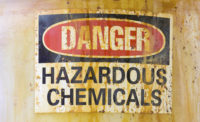CSB identifies cause of HF leak in Texas


|
A leaky flange with a long history of trouble appears to be at the root of a March 5, 2012 release of hydrofluoric acid (HF) from a CITGO refinery, according to the Chemical Safety Board (CSB).
The CSB team investigating the incident in Corpus Christi, Texas noted last week that this was the second release of HF at that facility within three years.
"On July 19, 2009, an intense hydrocarbon flash fire resulted in a release of hydrofluoric acid in the same process unit as the March 5th incident," said Johnnie Banks, Team Lead for the CSB. "The fire, which burned for several days, critically injured one employee and another was treated for possible HF exposure. As a result of the 2009 accident, CITGO reported to the Texas Commission on Environmental Quality that approximately 21 tons of HF released from alkylation unit piping and equipment."
The latest HF release did not cause any injuries, but Banks said the CSB nonetheless is taking the accident very seriously. "HF is highly corrosive and toxic. Absorption through the skin and underlying tissue can produce fatal cardiac arrest and inhalation causes damage to the linings of the lungs."
Since arriving on the scene the day after the HF release, the CSB investigation teams have conducted about 20 interviews, examined the accident scene and designed testing to estimate the total amount of process stream that was released to the atmosphere during the incident.
The team has determined that the March 5th leak occurred due to the failure of the seal on a 12 inch flange on a process vessel in the Alkylation unit.
Banks said that leaks have been reported at that flange as far back as September 2011. "In late January of this year, maintenance was performed on the flange, tightening the existing bolts, but the leak persisted. Further maintenance was performed on February 10 – over three weeks prior to the actual incident. At that time workers replaced the flange bolts and a work order was submitted to order a clamp to enclose the leak.
"The unit was not shut down; rather the clamp was ordered in the hopes that its installment would stop the leak. The proposed design of the new clamp was rejected three times over the next three weeks and had not been installed by March 5th."
On that day, the leak from the piping flange on the 12-inch line worsened. "Process liquids containing hydrocarbons and about 5% HF were released in a steady stream which worsened through the late afternoon," said Banks.
The CSB has determined that the March 5th incident resulted in the release of between 300 and 500 pounds of HF.
Eventually, the release was detected by sensors that triggered the alkylation unit’s automatic water cannons, designed to capture airborne HF. Automatic water cannons are intended as the last line of defense in the event of a release of HF.
Water cannons were once again activated by an HF release on March 10th and 11th as the refinery was restarting the unit. Banks said that the company was aware that the water cannons might be triggered by the planned work activities.
"Although the two additional releases were small in quantity the CSB is concerned that management accepted that the water cannons could be triggered. The facility is routinely using the water cannons as release mitigation for maintenance activities when in reality they should not be used as the last line of defense."
Banks said the investigators will be examining commonalities between the 2009 HF release and the March 5th incident.
"The facility’s continued reliance on the water cannons to “control” an HF release raises serious concerns regarding the facility’s management systems and control."
Looking for a reprint of this article?
From high-res PDFs to custom plaques, order your copy today!




